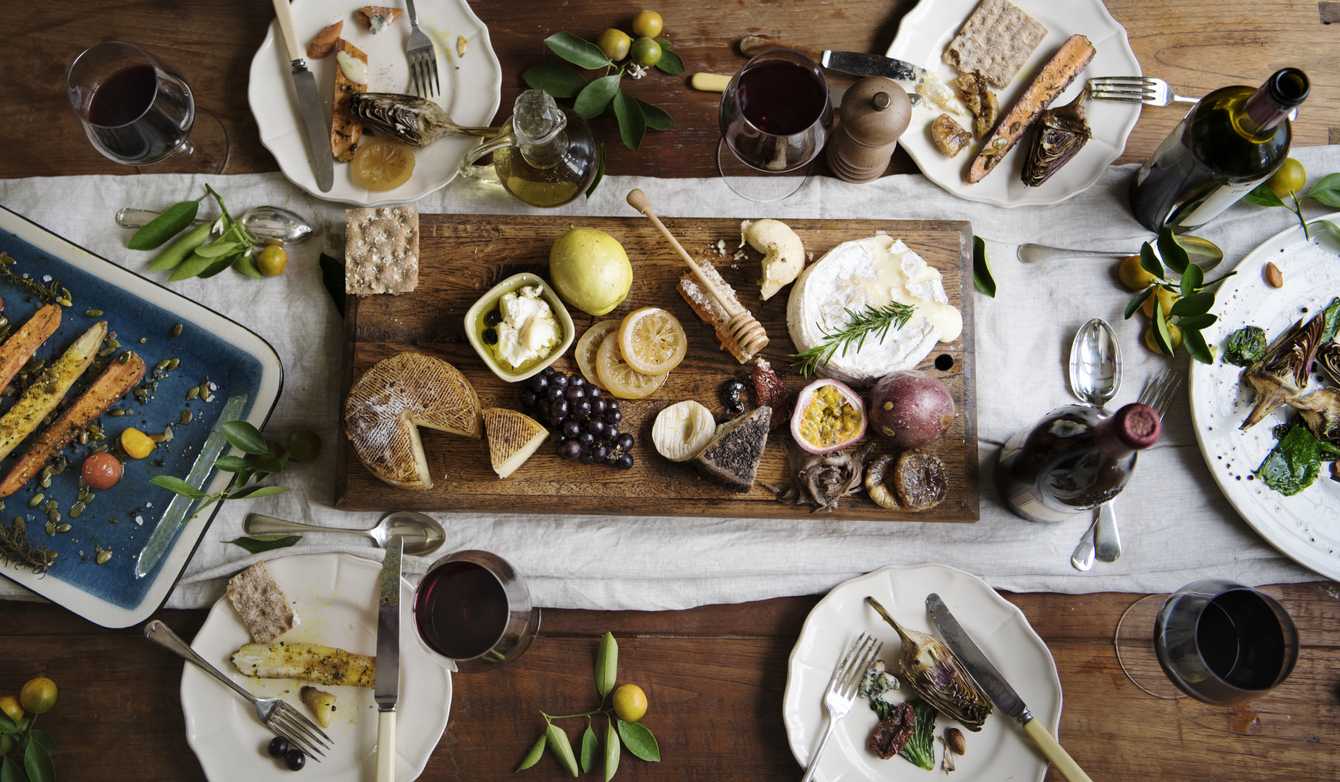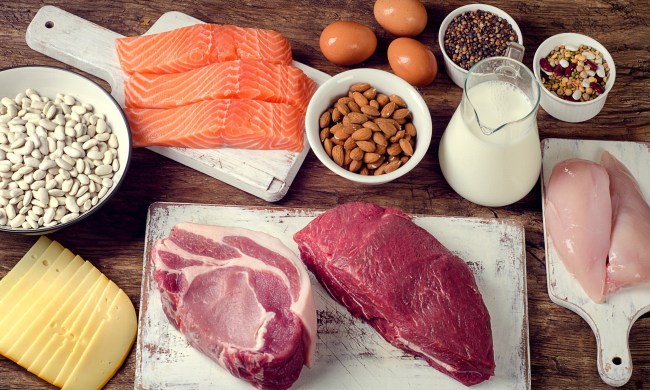France is the pinnacle of culinary romance and gastronomical luxury, renowned for its sophistication and simplicity. From the haute cuisine of Paris to the fruits de mer from the Mediterranean Sea, the effortless elegance of French cuisine comes from a few essential ingredients and time-honored techniques that have influenced most of the culinary styles we use today.
Julia Child’s Mastering the Art of French Cooking brought French food from the bistro to the kitchens of home cooks all over the world. She introduced America to an entirely new world of cuisine and proved that with practice, any home cook can utilize French cooking methods.
While understanding the history and techniques are the first step of any cultures cooking, to the French the most important is “Pour bien cuisiner il faut de bons ingrédients, un palais, du coeur et des amis.”
The history of French cuisine
The origins of French cuisine can be traced back to the early 14th century, when food was scarce for most people the aristocracy frequently dined on extravagant feasts heavily influenced by Italian culture.
A cook to the Court of France named Guillaume Tirel, commonly referred to as Taillevent, began crafting unique dishes for the royals, leading him to be considered one of the first “professional” chefs. He wrote a collection of medieval
In the 1600s, the French culinary identity we know today began to be defined as chefs such as François Pierre La Varenne and Marie-Antoine Carême emerged and developed their distinct flavors and styles. They focused on using fresh, seasonal, and regional French ingredients like cheeses, herbs, and wine, which would become the cornerstone of French cooking.
Chef François Pierre La Varenne wrote Le Cuisinier françois and Le Pâtissier françois, two of the most influential cookbooks in early modern French cuisine. In his works, he details
Marie-Antoine Carême is considered one of the first internationally renowned celebrity chefs. A cook to royalty, he created the style of cooking known as haute cuisine, which would become synonymous with Parisian food culture for years to come.
During the 19th century, Chef Auguste Escoffier would modernize French cooking methods and
The French dining style
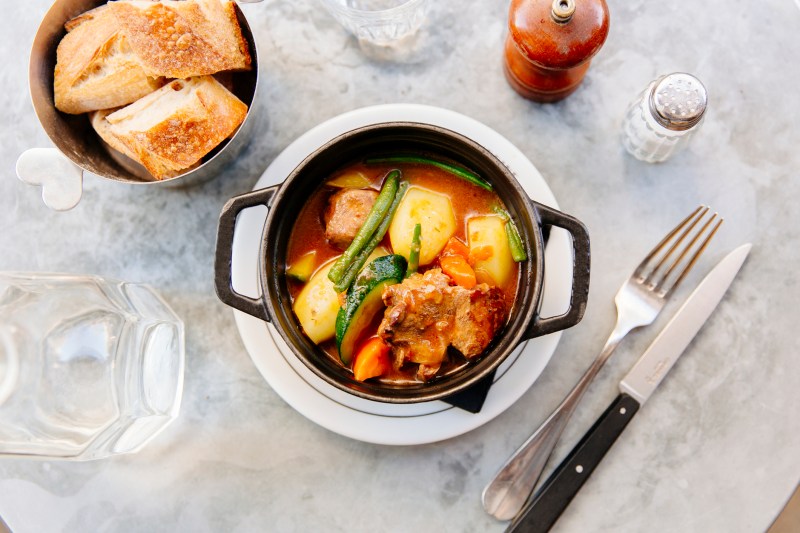
As with any culture, the French have customs around dining and etiquette. While traditions have changed over time, some definitive factors will always be part of enjoying French cuisine.
Le petit déjeuner
Breakfast is traditionally a small meal usually consisting of French bread with butter and honey or jam with a café au lait or tea.
Le déjeuner
A typical French lunch will consist of a starter (une entrée), such as a mixed salad, soup, terrine, or paté or a traditional sandwich like a Croque monsieur or Jambon beurre. A sit-down lunch usually includes a main dish (le plat principal) of meat or fish with vegetables and cheese and is commonly a two-hour mid-day meal.
Le dîner
A traditional French restaurant dinner often consists of three courses, hors d’œuvre, plat principal (main course), and a cheese course or dessert generously accompanied by bread and wine.
Apéritif
Apéritif means “to open the appetite” and are beverages that are served before a meal. Commonly served at a gathering before a meal called Apero, the most popular apéritifs are Pastis, Crémant d’Alsace, Champagne, and Kir.
Digestifs
Digestifs are traditionally Cognac, Armagnac, Calvados, Eau de vie, or fruit alcohols that are served at the end of the meal after dessert but before coffee.
Toasts
A traditional French toast is “à votre santé” which means “to your health” or more commonly shortened to just “santé.”
Baguettiquette
When enjoying bread with your meal, the French never set their bread on top of the plate but rather on the table to the side of the plate.
The art of French cuisine
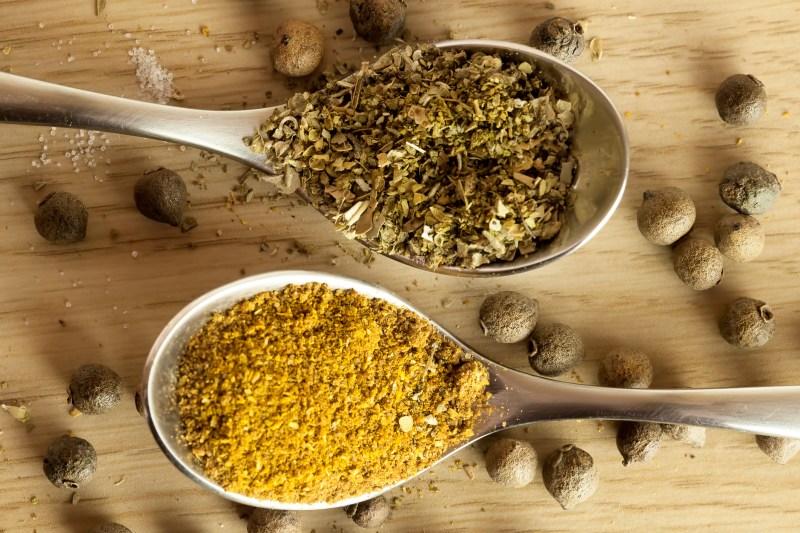
French cooking focuses on the appreciation of food from the ground to the plate. While it is often thought to be a complicated culinary style to recreate at its core the basics of French food are simple ingredients combined with time and a few notable techniques.
Traditional French ingredients
Cooking with the freshest local and seasonal ingredients is a fundamental part of culinary culture throughout the country. Each region has its distinct dishes and traditions that originated based on the produce harvested and animals raised in that area.
An important element of French cooking is minimal food waste. As a result, many
There are a handful of ingredients that are considered essential to any French kitchen.
French butter
French butter is the cornerstone of the country’s cuisine and is regarded worldwide for its rich and unique flavor. Unlike others, French butter is cultured, which means the cream is left to ferment before it is churned which gives the butter a deeper taste. In addition, French law requires butter to contain at a minimum 82% butterfat, which is higher than in other countries.
Crème Fraîche
A cultured cream, French for “fresh cream”, that is similar to sour cream in texture and flavor. Creme fraiche is used as a condiment or thickener in many appetizers, dinners, and desserts.
Dijon mustard
This mustard, made from brown mustard seeds and white wine verjuice, is the quintessential condiment and traditional mustard of France. It is named after the town of Dijon in Burgundy, which was the center of mustard making in the late Middle Ages. Dijon mustard is used widely in French
Herbes de Provence
Herbes de Provence is widely considered to be one of the most essential spice blends in culinary history. Originating in Southern France, it’s aptly named for the combination of aromatic summertime herb,s which grow wild and abundant in the hills of Provence.
Traditional Provençal herbs are said to include thyme, basil, rosemary, tarragon, savory, marjoram, oregano, and bay leaves. Whether used together or alone, these herbs of Provence are a core element in French and Mediterranean cuisine.
Fleur de sel
Meaning “flower of salt,” this is a delicate, flaky rare form of sea salt harvested in parts of Northern France. Fleur de sel is a finishing salt that enhances the taste of soups, salads, fish, meat, fruit, vegetables, and desserts.
Leeks
One of the top five vegetables in French cuisine, Leeks are a member of the garlic and onion family with a milder, sweet, oniony flavor. They are common in many French salads soups, stews, pasta.
French bread
The tradition of making bread in France is one of the defining symbols of French culture. There is a wide variety of French bread but the most common are baguette, French bread, brioche, croissant, and pain de campagne.
French wine
Known for its bon vin (or fine wine), France has one of the most productive wine regions in the world. In addition to being served alongside a meal, wine is also used to create sauces and stews.
French cheeses
The French produce and eat more cheese per person than in any other country. Some of its most famous varieties include Camembert, Brie, Roquefort, and Chevre.
The five mother sauces
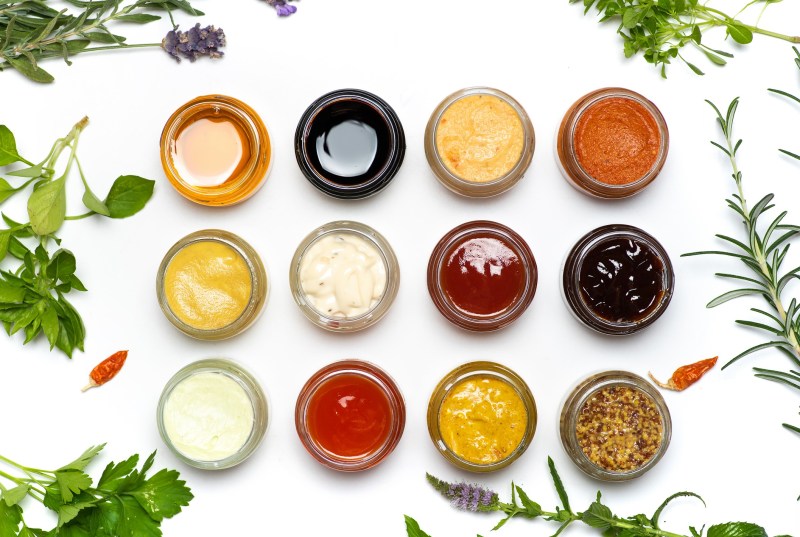
Developed by French chef Auguste Escoffier, The mother sauces are the base for a variety of traditional French sauces used in a wide array of classic recipes, including veggies, fish, meat, casseroles, and pasta.
Béchamel
Béchamel is made by thickening hot milk with a simple white roux that is often flavored with onion, cloves, and nutmeg. Béchamel the base for some of the most popular white, cream, and cheese-based sauce
Tomato
This is a classic tomato sauce that is traditionally thickened with roux. This sauce more flavorful tomato sauce is used in pasta, soups, and stews.
Hollandaise
Hollandaise is made by emulsifying clarified butter and lemon juice into warm egg yolks. It can be used on its own, but it is also the base for Béarnaise sauce and Dijon sauce.
Velouté
Velouté sauce is made by thickening white stock with a roux. and then simmering it for a while. Chicken velouté is the base for Supreme Sauce; Veal velouté becomes the Allemande Sauce, and fish velouté for White Wine Sauce.
Espagnole
Espagnole is made by thickening brown stock made from roasted bones with a roux, tomato purée, and mirepoix. Espagnole is traditionally further refined to produce a rich, deeply flavorful sauce called a demi-glace, which is the base for sauces and gravies.
Traditional French cooking techniques and terms
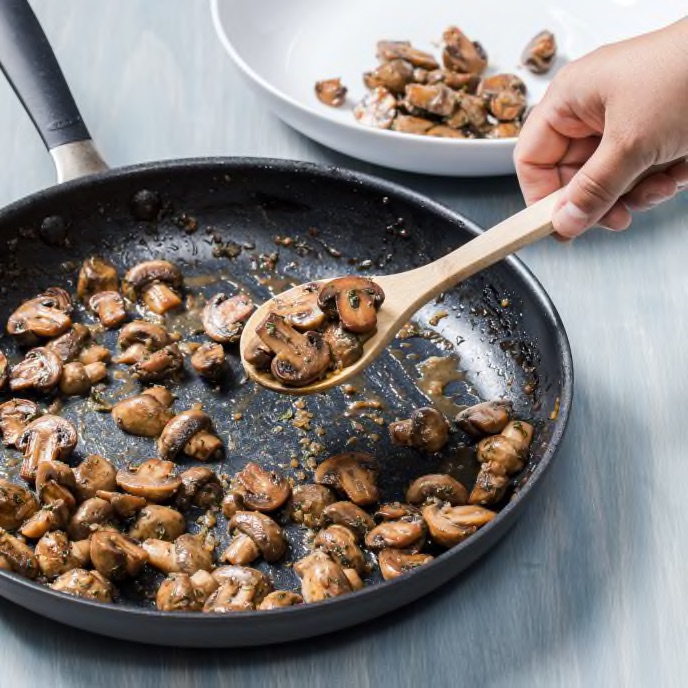
These traditional techniques and styles were established by the forefathers of French cuisine and have now become the foundation of cooking methods all over the world.
Mise en place
The concept of mise en place or “everything in its place” refers to organizing the kitchen so that all the elements needed for cooking are within reach.
Confit
Confit is a cooking method that involves salting and slowly cooking foods in fat at a low temperature.
Flambé
Typically used in desserts, flambéing uses alcohol to create a sauce that is cooked over high heat to remove the alcoholic properties and render the flavors from the spirit into the sauce.
Sauté
From the French word sauter, meaning to jump, sautéing is a cooking method where food is quickly pan-fried in olive oil or butter.
Braise
A method most commonly used to prepare meats involves quickly searing food and then cooking it in a seasoned liquid over low heat.
Poach and sous-vide
Poaching is a moist-heat cooking technique, where food is boiled in liquid. Sous-vide is a type of poaching, where food is sealed in plastic and cooked in temperature-controlled water.
Julienne
The julienne is a knife cut where vegetables are sliced into very thin, evenly cut strips.
Mirepoix
A mirepoix is a combination of diced carrots, onions, and celery slow cooked in butter or
Traditional French dishes
Ratatouille Provençale
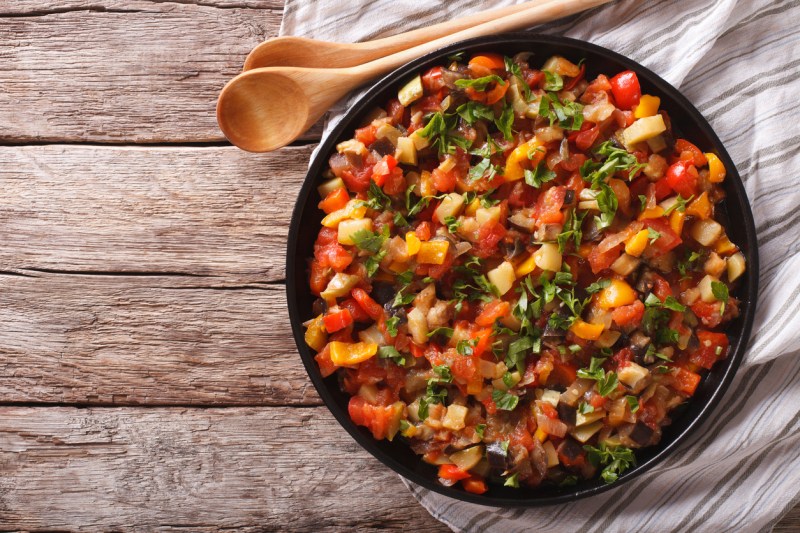
(By Anthony Herve, chef de cuisine, The Cosmopolitan of Las Vegas)
This Provençal dish (from Provence) is a colorful medley of vegetables, like eggplant, zucchini, onion, peppers, and garlic, that create a thick stew.
Ingredients:
- 2 onions, thinly sliced
- 2 Roma tomatoes
- 1 green zucchini
- 1 yellow squash
- 1 eggplant
- Herbes de Provence, to taste
- Extra virgin olive oil, to taste
- Salt and fresh ground pepper
Method:
- Preheat oven to 400 degrees Fahrenheit.
- Put the sliced onions in a pan and cook over medium heat with extra virgin olive oil, stirring occasionally until the onions are soft and nicely caramelized.
- While the onions are caramelizing, slice the tomatoes, zucchini, squash, and eggplant into ¼-inch slices.
- When the onions are cooked, tightly layer the sliced vegetables over the caramelized onions in a baking or roasting pan.
- Generously season the ratatouille with herbes de Provence, salt, and pepper. Drizzle with olive oil.
- Put the ratatouille in the pre-heated oven and cook for 30 minutes, or until the vegetables are soft.
Quiche Lorraine
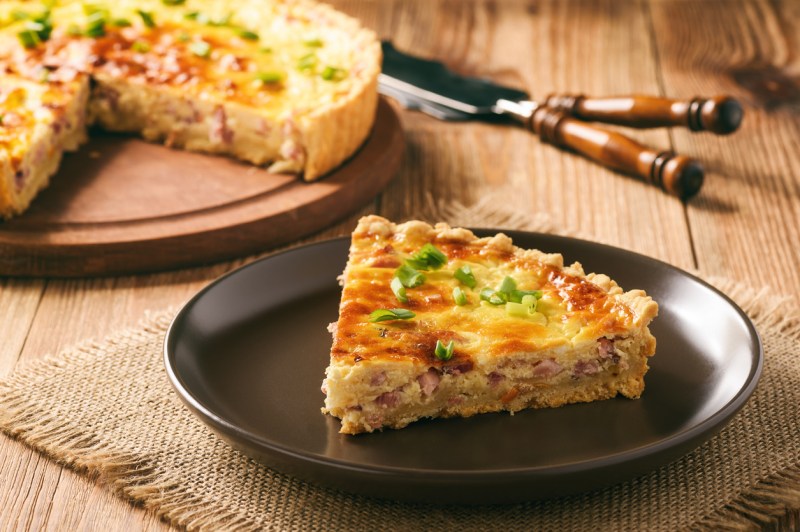
(From New York Times Cooking)
Quiche is a savory egg dish baked into a pastry crust. The most famous is Quiche Lorraine, a warm pie of eggs, bacon, onion, gruyere cheese, cream, and seasoned with salt, pepper, and nutmeg.
Ingredients:
- Pastry for a one-crust nine-inch pie (see pastry recipe)
- 4 strips bacon
- 1 onion, thinly sliced
- 1 cup Gruyère or Swiss cheese, cubed
- 1/4 cup grated Parmesan cheese
- 4 eggs, lightly beaten
- 2 cups heavy cream or 1 cup each milk and cream
- 1/4 teaspoon nutmeg
- 1/2 teaspoon salt
- 1/4 teaspoon freshly ground pepper
Method:
- Preheat the oven to 400 degrees Fahrenheit.
- Line a 9-inch pie plate with the pastry. By all means, build a rim with the pastry and flute it. This is essential for the amount of custard indicated in this recipe.
- Cover the bottom of the pastry with a round of parchment paper and add enough dried beans or peas to partly fill the shell. Bake for 10 minutes.
- Reduce the oven heat to 375 degrees Fahrenheit. Remove and discard the beans and parchment paper and set the pastry-lined pie plate aside.
- Cook the bacon until crisp and remove it from the skillet. Pour off all but one tablespoon of the fat remaining in the skillet. Cook the onion in the remaining fat until the onion is transparent.
- Crumble the bacon and sprinkle the bacon, onion, and cheese over the inside of the partly baked pastry.
- Combine the eggs, cream, nutmeg, salt, pepper, and Tabasco sauce to taste. Strain the mixture over the onion-cheese mixture. Slide the pie onto a baking sheet.
- Bake the pie until a knife inserted one inch from the pastry edge comes out clean, about 25 minutes. Remove to a wire rack. Let stand five or 10 minutes before serving.
Crepes
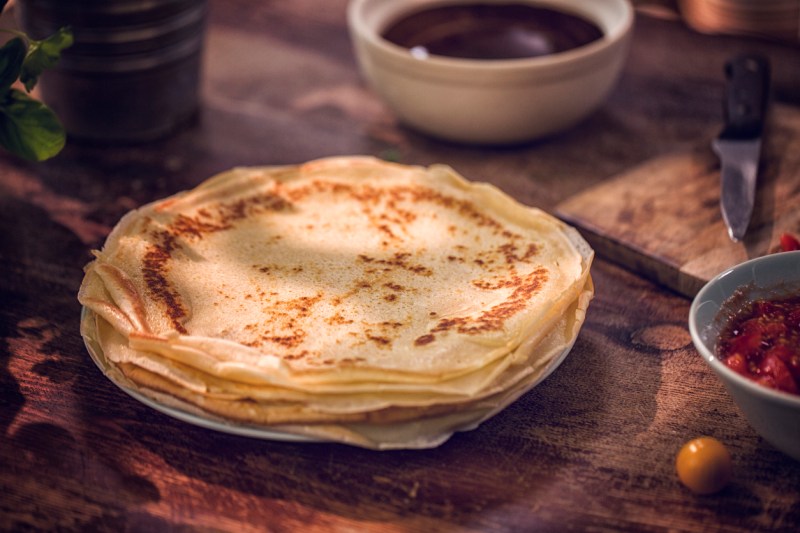
These thin pancakes are filled with a sweet spread like jam, custard, or chocolate, or served as a savory dish with heartier food like ratatouille, ham, or eggs.
Ingredients:
For sweet:
- 3 large eggs
- 2 1/3 cups milk
- 1/4 cup sugar
- 1 teaspoon vanilla
- 1 pinch of salt
- 2 1/3 cups flour
- Butter for the pan
For savory:
- 2 eggs
- 1 1/2 cups milk
- 2 tablespoons butter
- 1/4 cup buckwheat flour
- 3/4 cup all-purpose flour
- 1 pinch of salt
- Butter for the pan
Tip:
Since crêpes are generally larger than pancakes, it’s best to use a larger 8-to 9-inch nonstick pan or a crêpe pan to ensure there is enough space.
Method:
- In a blender, pulse the eggs, milk, sugar, vanilla, salt, and flour (use ingredients based on sweet/savory) for 7 to 10 seconds, or until the batter is smooth. Pour into a bowl. (The batter can be refrigerated, covered, for up to 3 days. If the batter thickens too much, add additional milk before cooking to thin it to the consistency of heavy cream.)
- Heat an 8- or 10-inch non-stick skillet or well-seasoned crêpe pan over medium heat until hot. Using one end of a stick of butter, coat the bottom of the pan with a thin layer of melted butter.
- Pour 1/3 cup of batter into the center of the pan. Immediately pick up the pan and tilt and swirl it to spread the batter evenly over the bottom.
- Cook for 1 to 2 minutes, or until the crêpe is golden on the bottom.
- Use a rubber spatula to loosen the edge of the crêpe all around. Hold the edge with your fingertips and gently, but quickly, flip the crêpe to the other side (or use a spatula if that feels more comfortable).
- Cook for another 30 seconds, or until the crêpe is golden on the bottom: Slide the finished crêpe onto a plate.
- Repeat until all the batter is used, stacking the crêpes on top of each other on the plate.
- Place one crêpe on a plate and fill it with your filling of choice. Either roll the crêpe or fold it into quarters and top with additional toppings if desired. Serve warm.
Chicken liver pâté

(By Crystal Reinwald, personal chef and cooking instructor, Austin, Texas)
Reinwald’s classic pâté mousse recipe uses chicken livers, and she likes to pair her rich spread with toasted baguette slices and bacon jam. The smoky sweetness of the latter brings out the savory notes of the pâté, making for a wonderfully balanced and indulgent snacking experience.
Ingredients:
- 1 stick unsalted butter, softened
- 2 shallots, minced
- 16 ounces fresh chicken livers, trimmed
- 2 tablespoons fresh thyme leaves
- 1/3 cup balsamic vinegar
- 4 tablespoons heavy cream, more if needed
- Salt, to taste
Method:
- Over medium heat, melt 1/2 of the butter until foaming. Add in the shallots and cook until they are translucent. Be careful to keep your heat low so that they don’t get any color on them.
- Add in the thyme, vinegar, and chicken livers. Crank up the heat to high while stirring everything in the pan. Cook until the liquid has reduced and the livers are brown on the outside but soft on the inside, 5-7 minutes.
- Remove from the heat and puree in a blender or food processor with the rest of the butter and the cream. Add more cream if it’s too thick. Season with salt, to taste.
- Refrigerate immediately in the serving dish you want to use. Pâté is ready once chilled, about 1-2 hours.
- Serve with toasted baguette slices or crackers.
Julia Child’s coq au vin
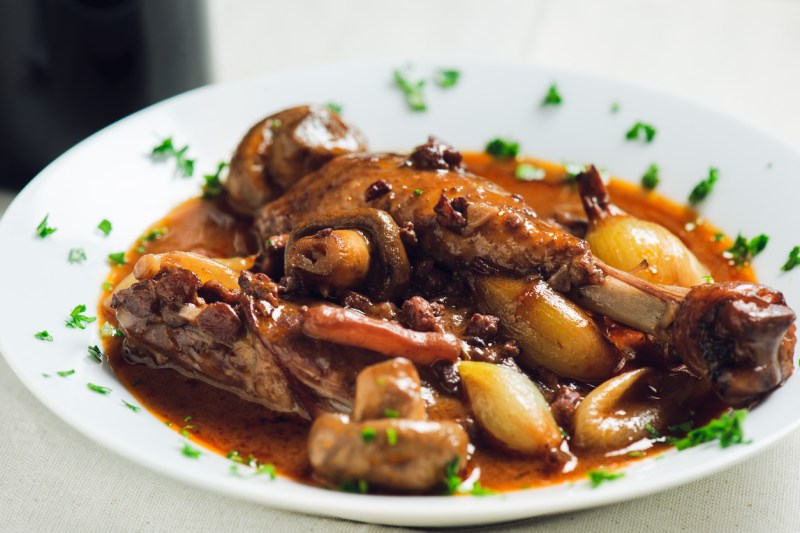
This classic chicken dish from Burgundy means “rooster in wine.” Pieces of bone-in chicken are braised in red wine with a little brandy, pearl onions, mushrooms, and carrots for a rich stew.
Ingredients:
- 4 chicken thighs
- 4 chicken drumsticks
- 1 1/2 cups red wine
- 1 cup chicken stock
- Optional: 1/4 cup brandy
- 3 strips of bacon, cut into 1/2-inch pieces
- 1 medium onion, quartered then thinly sliced
- 4 medium carrots, cut into 1-inch pieces
- 4 garlic cloves, minced
- 2 tablespoons tomato paste
- 2 teaspoons fresh thyme leaves
- 8 ounces mushrooms, thickly sliced
- 8 ounces pearl onions, peeled
- Beurre manie
Method:
- Place the chicken thighs and drumsticks in a medium-sized bowl and pour the wine, chicken stock, and (if using) the brandy over the top. Prep the vegetables.
- Add the bacon to a large skillet or braiser over medium-high heat. Cook until the bacon is crispy, about 8 minutes, then remove it from the pan with a slotted spoon.
- Remove the chicken from the wine marinade (save the wine) and dry the chicken with paper towels. Working in 2 batches if needed, place the chicken in the pan, skin side down. Sear until it is golden on both sides (about 5 minutes on each side) then remove the chicken from the pan. Pour all but 2 tablespoons of the bacon/chicken oil into a heatproof dish and set it aside.
- Add the sliced onion and carrots to the pan and let them cook until the onion is golden brown, about 7-8 minutes. Add the garlic to the pan and let it cook for 1 minute.
- Push the vegetables to the side of the pan and add the tomato paste. Cook the tomato paste until it is fragrant and begins to darken. Pour the reserved wine marinade into the pan, scraping the bottom to remove any stuck-on bits.
- Nestle the chicken into the pan and sprinkle the thyme over top. Cover the pot, turn the heat to low, and simmer for 20 minutes.
- Pour 1 tablespoon of the reserved oil (or use olive oil) into a large skillet. Add the mushrooms and saute over medium-high heat until brown, about 10 minutes.
- Add the pearl onions to the pot with the chicken and cook for 10 minutes more.
- In a small bowl mix together your choice of beurre manie. Remove the chicken from the pan then add the beurre manie. Stir it into the sauce and let it thicken. Season to taste with salt and pepper.
- Add the chicken back into the pan and top with the cooked bacon and mushrooms. Sprinkle with a little fresh thyme.
Bouillabaisse
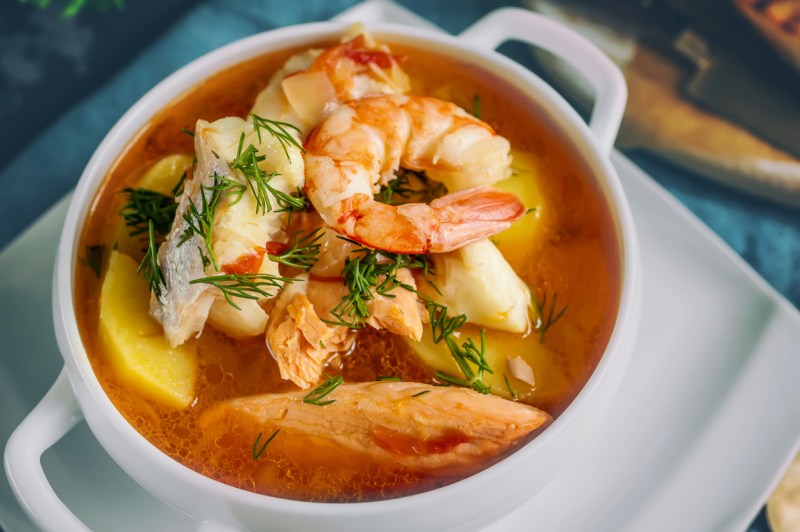
(By Nicholas Morales, executive chef, Bar Marseille, Averne, New York)
Ingredients:
For the fish stock:
- 1 large onion, minced
- 1 leek (whites only), minced
- 2 cloves garlic, crushed
- 1/2 head of fennel, minced
- 1 1/2 pounds of fish heads or bones
- 3-4 ripe plum tomatoes
- Peel of 1 orange
- 1 celery stalk, cut into pieces
- 1 spring of thyme
- 1 bay leaf
- Pinch of cayenne (optional)
- 1 teaspoon pastis
- 1 cup bonito flakes
- 2 quarts boiling water
For the bouillabaisse:
- 1 to 1 1/2 pounds white fish fillets
- 1/2 pound (21-25) jumbo shrimp, peeled and deveined
- 1 pound mussels or clams
- 1 tablespoon pastis
- 1/2 teaspoon saffron threads
- 1/4 cup olive oil
- 1 pound potatoes, peeled and cut into quarters in slices
- Salt, to taste
- Fresh ground black pepper, to taste
- Pastis, to taste
- Fish stock (full quantity)
- 1 baguette, cut into slices
Method:
- To make the fish stock, heat olive oil in a large heavy-bottomed stockpot over medium heat. Once the oil is hot, begin adding the onions, leek, and fennel, stirring often to cook the vegetables gently. The vegetables should develop a light color and soften into the olive oil. If necessary, lower the heat.
- Once the vegetables soften, increase the heat and add any fish bones or heads you would like to use. At this point, you want to begin stirring aggressively. It’s fine for the fish to get bruised and/or fall apart.
- After 7-10 minutes of stirring the fish, add orange peel, thyme, cayenne, celery, bay leaves, pastis, and bonito flakes. Lower heat again to prevent burning and cook for 10 min, stirring constantly.
- Pour boiling water into the pot and lower the heat to medium-low. Let simmer for 25 minutes.
- Add the contents of the pot to a food mill, blender, or food processor (or use an immersion blender) and lightly blend. After blending, pass the liquid through a fine-mesh strainer and set aside.
- Cut fish filets into 4 oz pieces and place them into a bowl with shrimp. Add pastis, a pinch of saffron, 1 teaspoon olive oil, salt, and black pepper. Very gently, taking care not to break the fish, toss the ingredients together. Cover the bowl in plastic wrap and let marinate for about 3 hours, if time is available.
- Pour the fish stock into a large, heavy-bottomed stockpot and turn up the heat to high, bringing the stock up to a boil. Once boiling, add the remaining crumbled saffron.
- Add potatoes to the pot and cook the potatoes for about 10 minutes. If using firm fish (like monkfish), add after cooking potatoes for 5 min; if using lighter fish, add after cooking for 10 minutes. Also, add mussels and shrimp.
- Taste broth and adjust seasoning as needed. Once potatoes are tender, you’ll be ready to plate.
- Rub the baguette slices with garlic and lightly toast.
- To serve, carefully take out all the seafood from the broth using a slotted spoon and transfer to plates. With a spoon, start transferring potatoes and broth to each bowl. Place sliced baguette on the side of each bowl.
Julia Child’s boeuf bourguignon
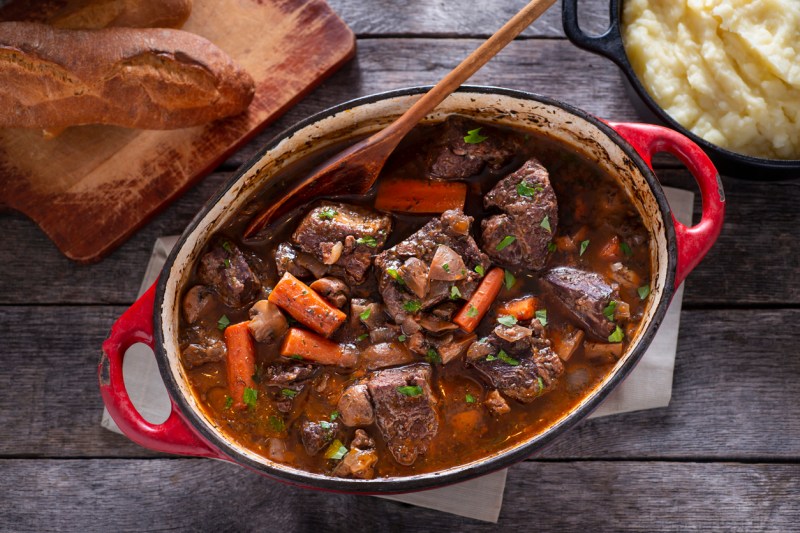
A famous stew from Burgundy starts with beef braised in red wine (preferably red Burgundy) with onions, carrots, garlic, mushrooms, bacon, and bouquet garni.
Ingredients:
- 6 slices bacon, cut into lardons
- 3 1/2 tablespoons extra-virgin olive oil
- 3 pounds stewing beef, cut into 2-inch chunks
- 1 large carrot, sliced
- 1 large white onion, sliced
- 1 pinch of coarse salt and freshly ground pepper
- 2 tablespoons all-purpose flour
- 3 cups red wine, like a chianti
- 2 1/2 to 3 1/2 cups beef stock
- 1 tablespoon tomato paste
- 2 cloves smashed garlic
- 1/2 teaspoon thyme
- 1 crumbled bay leaf
- 18 to 24 small pearl onions
- 3 1/2 tablespoons butter
- 1 herb bouquet (4 sprigs parsley, 2 sprigs thyme, 1 bay leaf)
- 1 pound fresh white mushrooms, quartered
Method:
- Simmer bacon lardons in 4 cups water for 10 minutes (Lardon is the French culinary term referring to thin strips of bacon, cut approximately 1/4-inch thick). Drain and pat dry.
-
Preheat oven to 450 degrees Fahrenheit. In a large Dutch oven, sauté the bacon in 1 tablespoon of oil for about 3 minutes, until it starts to lightly brown. Remove with a slotted spoon and set aside.
-
Dry the beef with a few paper towels for better browning. In batches, sear the beef on all sides in the Dutch oven. Set aside with the bacon.
-
Back in the pot, add the sliced carrots and onions; sauté in fat until browned, about 3 minutes. If there’s any excess fat, drain it now.
-
Add the bacon and beef back to the pot. Season with 1/2 teaspoon coarse salt and 1/4 teaspoon ground pepper. Toss. Sprinkle with flour and toss once more. Place in the center of the oven for 4 minutes.
-
Remove pot from oven; toss beef and place back in the oven for 4 more minutes. Remove the pot from the oven and reduce the heat to 325 degrees Fahrenheit.
-
To the pot, add the wine and stock. The liquid should barely cover the meat and vegetables. Add the tomato paste, garlic, and thyme. Bring to a light simmer on the stove, then cover and simmer in the lower part of the oven for 3 to 4 hours, or until the meat is easily pierced.
-
In the last hour of cooking, bring 1 1/2 tablespoons butter and 2 teaspoons oil to medium heat in a sauté pan. Add the pearl onions and toss around in the fat until they’ve browned 10 minutes. Then stir in 1/2 cup beef stock, a small pinch of salt and pepper, and the herb bouquet. Reduce the heat to low and simmer the onions for about 40 minutes, until the liquid has evaporated, and the onions are tender.
-
Remove the onions and set aside. Discard the herb bouquet and wipe out the skillet. Add the remaining butter and oil and bring to medium heat.
-
Add the mushrooms and cook for about 5 minutes, shaking the pan to coat with the butter.
-
Place a colander over a large pot. Drain the beef stew through the colander and into the pot. Place the pot with the sauce over medium heat and simmer for about 5 minutes, skimming any fat on top. Pour the beef and vegetables back into the Dutch oven. Add the pearl onions and mushrooms to the pot. Pour the sauce over the beef mixture and simmer an additional 3 to 5 minutes.
Souffle
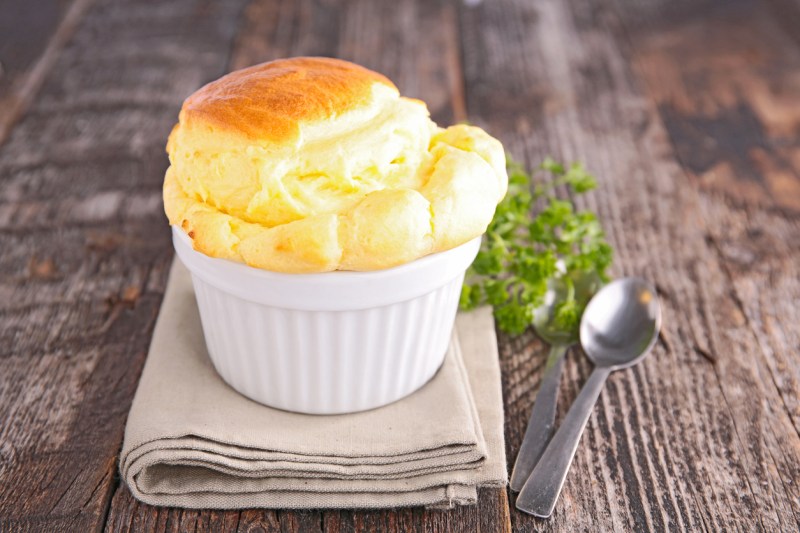
(From Epicurious)
A souffle is made by combining a base of egg yolks and sweet or savory ingredients, like chocolate for a sweet souffle or vegetables for a savory one, with beaten egg whites. Air bubbles in the egg whites expand during cooking, giving a souffle that classic, billowy top.
Ingredients:
- 4 tablespoons (1/2 stick) butter, softened, plus additional for coating ramekins
- 1/2 cup sugar, plus additional for coating ramekins
- 1/2 cup all-purpose flour
- 2 tablespoons Grand Marnier
- 2 tablespoons simple syrup
- 16 small amaretti cookies
- 1 1/4 cups whole milk
- 1/2 vanilla bean
Method:
- Preheat oven to 375 degrees Fahrenheit. Generously butter ramekins and coat them with sugar, knocking out excess. Bring a large saucepan of water to boil.
- In a small bowl, stir together 4 tablespoons of butter and flour to form a paste.
- In a second small bowl, stir together Grand Marnier and simple syrup. Add cookies, tossing lightly to coat, and let soak while preparing the remaining ingredients.
- Transfer milk to a large saucepan. Split 1/2 vanilla bean length¬wise and scrape seeds into the milk. Add bean. Set over moderate heat and bring to a boil. Remove from heat and whisk in butter-flour mixture. Return to moderate heat and cook, whisking consistently, until thickened and smooth, about 2 minutes. Remove from heat and whisk in egg yolks and 1 egg white. Transfer the soufflé base to a large bowl and discard the vanilla bean. In the second large bowl, using an electric mixer, beat the remaining four egg whites just until soft peaks form. Gradually beat in 1/2 cup sugar.
- Whisk 1/4 of beaten egg whites into soufflé base to lighten. Gently but thoroughly fold in the remaining whites. Spoon 1/2 of the batter into ramekins, filling each halfway. (Alternatively, spoon batter into a large pastry bag and pipe into ramekins.) Transfer 2 soaked cookies to each ramekin. Top with remaining batter. Arrange ramekins at least 1 1/2 inches apart in a large baking pan and add enough hot water to the pan to reach 2/3 up sides of the ramekins.
- Bake soufflés until puffed and golden, 20 to 25 minutes. Remove pan from oven and transfer ramekins to rack. Sift confectioners’ sugar over, then transfer ramekins to dessert plates. With two forks, pull open the center of each soufflé and pour some crème anglaise into the opening. Serve immediately.
French onion soup

(From the New York Times)
This is likely one of the classic French dishes you are the most familiar with, as it is a staple on many menus. Onion soup has been known in France since medieval times, but the version we all know and love emerged in Paris in the 19th century. French onion soup can seem complicated, but it’s fairly easy to put together. With beefy stock and melted cheese on top, it’s a great meal for a cold night.
Ingredients:
- 3 tablespoons unsalted butter
- 3 to 4 large red or yellow onions (about 3 pounds), peeled and thinly sliced
- 3/4 teaspoon kosher salt, plus more to taste
- 2 quarts beef stock (8 cups)
- 1 cup dry white wine
- 1 tablespoon dry sherry
- 1 tablespoon all-purpose flour
- 1/2 teaspoon black pepper, plus more to taste
- 8 to 12 (1/2-inch) slices French bread (from 1 loaf)
- 1 1/2 cups grated Gruyère cheese
Method:
- Melt the butter in a heavy Dutch oven over medium heat. Add onions and 1/2 teaspoon salt, stir, and cover, letting onions soften for 5 minutes.
- Remove the lid and let the onions caramelize until golden brown over medium heat, stirring occasionally. Adjust heat if onions are browning too quickly. The caramelization process may take 45 to 60 minutes.
- Meanwhile, warm broth in a saucepan over low heat.
- Once the onions are caramelized, add the wine and sherry to the pot and allow the mixture to come to a boil. Stir in the flour and let it thicken for 1 to 2 minutes.
- Slowly add the heated broth, 1/4 teaspoon salt, and 1/2 teaspoon of black pepper to the onion mixture and boil uncovered for 10 minutes. Add more salt and pepper to taste if necessary.
- Heat the broiler, and arrange individual ovenproof soup bowls on a baking sheet.
- Ladle soup into bowls and top with bread slices. Sprinkle each bowl generously with Gruyère cheese.
- Broil for 1 to 2 minutes, until the cheese melts and browns (be sure to watch while broiling to avoid burning the cheese). Serve immediately.
